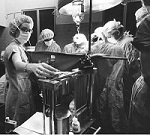
The Anesthesia Gas Machine
Michael P. Dosch CRNA PhD
University of Detroit Mercy - Nurse Anesthesia
This site is https://healthprofessions.udmercy.edu/academics/na/agm/index.htm.

The Anesthesia Gas Machine
Michael P. Dosch CRNA PhD
University of Detroit Mercy - Nurse Anesthesia
This site is https://healthprofessions.udmercy.edu/academics/na/agm/index.htm.
Revised May 2025
An anesthetist who knew how to use an Excel could easily walk up to a Modulus or any of the Narkomeds and use them with very few problems, and essentially no training time or reading. However, the new machine features such as advanced ventilation modes, computer and monitor integration, and the electronic checklist are very different than anything that has gone before. New models are substantially different- look at the three different approaches to flowmeters in the Aestiva or Aespire (mechanical needle valves and glass flowtubes), Fabius/Apollo (mechanical needle valves, electronic display of flows backed up by common gas outlet flowmeter), and Aisys and Perseus (all electronic gas mixer, digital display in which the inspired oxygen, carrier gas flow, and total fresh gas flow are set). And Et control really shuffles the deck- instead of setting process variables (what flow and concentration do I want to give?), we now set the desired outcomes (patient's end tidal oxygen and anesthetic agent), and allow the machine to choose the best gas flows and concentrations to achieve the end result quickly and safely. The bottom line? Comfort with one make and model translates much less to other models than it used to.
Furthermore, anesthesia practice is changing. Spontaneous ventilation for longer than a few moments during general anesthesia was rare. Now because of the laryngeal mask airway it is much more common. Substantial cost and environmental impact of the volatile agents are driving the use of low flows (and total IV anesthesia [TIVA]). When users at a total fresh gas flow of 1 L/min find inspired oxygen dropping slowly, or a 2-3% difference between dialed and end-tidal sevoflurane in the middle of a case, they may have trouble remembering that these are expected findings at low fresh gas flow.
Comfort with the monitoring technology can be an issue. I know that a little ball in a glass tube would drop unless oxygen is flowing- a physical fact that I can sense. You mean my trust must now repose in a green bar graph??
The new machines simply cannot be used safely without a personal and institutional commitment to time spent in training and reading.
With the new machines, operating costs may be higher. Carefully compare the cost of disposables per case (e.g. spirometry tubing, carbon dioxide granule canisters, breathing circuits). This can be mitigated by several tactics:
A few pearls from folks who have "been there":